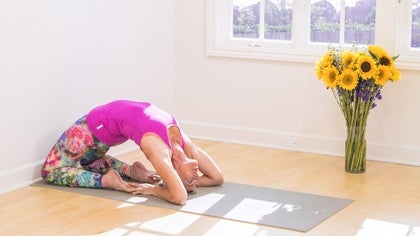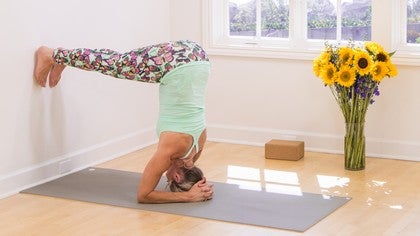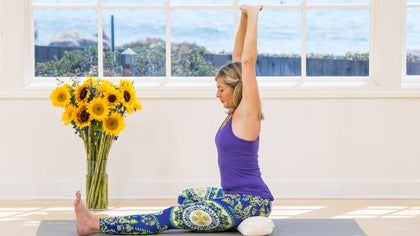Description
About This Video
Transcript
Read Full Transcript
(water rushes) Good, namaste, welcome back. So this series is dedicated to exploring. I think there's probably a place for all of us to go here, and if you're brand new to inversions, don't be afraid, we have plenty of options leading up. One thing I will say is I really do recommend, with shoulder stand and its variations, I suggest watching first and then trying it out, or backing up and then trying it out the second time with me, because you wanna be absolutely sure that your head is not moving in shoulder stand while you're in it, 'cause it will create problems in the neck. Okay, so that's an agreement that we're gonna make with each other.
But, really listen to your body and see what feels right to try. We'll begin in head stand. I tend toward doing my head stands before my shoulder stands, because, as we may discover, the head stand tends to be a little bit, it has a little more heat in it than the shoulder stand. Shoulder stand is a cooler posture in general, you can feel it in the breath. And so I tend to have my shoulder stand be something I do toward the end of my practice.
I'm hoping that you have had a good practice at this point as you move into these postures. So let's begin. One nice thing about the way we've got this set up is that we've got a wall here, and I'm hoping that you've got a wall at home where it's close enough to your computer and you can use the wall, 'cause it is just so helpful. When we come in, if you happen to have a block nearby, it's worth, we'll explore with the block shortly. But as you come in, if you've got the option of placing the feet up against the wall, please do, so the balls of the feet are right against the wall.
This setup is pretty essential. There's plenty of ways to do it not well. The most common is, as the fingers are interlaced, I like to have one pinky finger flush right next to the other so that that bottom one doesn't get squished. I place my hands down in a cup. And what's really common for people to do is take their elbows too wide and their triangle, their base of support isn't solid.
So I need to have a nice triangle, so if there was an arm here, it would be the same size as the two that I've got, elbows under the shoulders. So I bring the top of the head lightly to the floor. And, in fact, what I like to do is practice in such a way that my head is barely touching the floor. Especially for you new folks to head stand, you wanna have the head barely graze the shoulders, move them way up the back, away from the ears. The navel draws in, and this is the place to begin lifting the hips up.
You can see that you can support yourself here with just your arms and shoulders if the navel draws up. Good, come down for a moment, pause. The series that's really useful to prepare you for this one is the series that I did on inner resources, cultivating your inner resources, because you've gotta get your navel to draw way up into the spine so that you can create some buoyancy and some lift. The issue with this head stand, with any of the inversions, is the body gets so heavy down here, how is it that we're gonna do that lift? That lift happens right here.
So let's try it again, okay? Interlace, open the thumbs, check your elbows and your shoulders, navel draws in, top of the head to the floor, okay, lightly to the floor, shoulders up away from the ears, and lift the hips. Good, lift the hips. And then see if you can take one foot up. And this may be the place to pause, sending the sit bones directly up, pushing into the wall, and you'll see, I'm gonna demonstrate what not to do.
See how my shoulders are coming around my ears? Pull up, don't let that happen. Lift the navel. Good, come back down, pause. (woman breathes deeply) Feel, pause and feel.
(woman breathes deeply) Good, hands under the shoulders, slowly rise. Okay, so let's try this again now. Potentially, we'll put the feet back on the wall. Potentially, we could lift the legs off, but let's only do that if the hips feel as though they are stacked over the shoulders. That's the game we're playing here, okay?
So let's come right back down again. Interlace, open up, head comes in, feel the balls of your feet against the wall, shoulders up, navel in, hips high, walk, walk. Okay, that may be it. Otherwise, can the thighs come right up against the rib cage, and can you balance here, drawing the shoulders away from the ears? And when I learned this, my teacher said two minutes like this, which we will not do right now.
But, as you're working on your head stand, two minutes here, eventually those hips are gonna know exactly where to be. The legs are simply an extension out of that relationship between the hips and shoulders. Remember everything we learned in the balance series, drawing all of it to the midline. (woman breathes deeply) And we breathe and we're steady. (woman breathes deeply) And then inhale here, exhale, we're gonna slowly, slowly come down.
Remember the core work, the navel drawing in toward the spine. (woman breathes deeply) Take a breath in child's pose first. Pause and feel. (woman breathes deeply) Now simply take your hands back behind you, place them on your heels. Come onto the top of your head so your forehead's right up against your knees.
You can tuck the toes under or you can keep the front of the feet on the floor. Draw your navel to your spine and mushroom the space between your shoulder blades. Breathe into that space. Forehead as close to knees as you can get. (woman breathes deeply) Good, this is a counterposture for your head stand.
(woman breathes deeply) And inhale here, exhale, releasing, child's pose once again. (woman breathes deeply) Good, slide the hands underneath the shoulders, slowly rise up. Let's just pause for a moment and feel the effect of that posture in your body. (woman breathes deeply) Good, well done. So now, what we'll do is we're gonna lie back, and we're making our way toward shoulder stand, which is a posture that many people practice for many minutes, a long time.
We'll take it in short increments on the way to shoulder stand. I recommend, as do many of the other teachers, that inversions are something that we wanna be doing every day. And I know the difference that I feel after having done an inversion, whether it's the full posture or on the way up. So I hope you enjoy this. Take the legs out to the side.
Now this is a time when it is useful to have the block nearby. You wanna place the hip right up against the wall, and we're gonna slide onto our back as the legs come up the wall, and we want our hips as close to the wall as possible. And lower your shoulder blades, turn the palms up. And just allow the whole torso to release into the floor. Now I like to imagine what's happening inside the legs, it's this kind of slow descent of fluid.
And I also like to notice what's happening with my breathing. How we'll change the shape of our body, and it completely changes the way in which we're breathing. You just notice what makes more contact with the floor, what parts of our body, as the breath comes into the body. Now if you'd like to take this one step further, bend the knees a little bit, put the feet down against the wall, and then curl the tail bone up, slide the block, any height you like, so I'll go for the middle way today, underneath the tail bone. It's very common to take it, if you're new, up too high into the lumbar.
It should feel just great, almost like no sensation at all. Now I could have my legs against the wall or I could let them float here. And I widen my toes, because there's two theories here. You can widen the toes, and that way I know that all of the muscles of my legs are engaged and there's a lift happening. Once I've got that lift and I'm here for a little bit, I might soften the legs and just let them relax and dangle.
I'm looking for this invisible center, where they can just be there quite easily. Now the key to this is my sternum, there's just a slight, remember the marionette, there' just a little bit of a length out my sternum to help balance the legs. So this is usually pretty delicious, and there are many, many reasons why not to take this any further. In fact, one of my teachers who I have immense respect for, Ramaswami, who studied directly with Krishnamacharya, he says that shoulder stand is not a posture that people in adult life should be doing if they didn't learn it at an early age, because it's too hard on the neck. The neck has come into a particular shape in our bodies, and it's just too hard.
So you choose for yourself whether you wish to go on, but be sure you do not turn your head left or right. Place the feet back into the wall, and slowly, slowly, tail bone comes up off the block. Now I'm gonna move the block out of the way. I wanna maybe interlace my fingers. If that's an option, interlace your fingers, but you wanna draw the arms in toward each other.
Place your hands on your hips or lower, ideally. And I can see my navel pretty clearly here, I wanna draw it in toward the spine because I need that extra support. I might come onto the toes. But, again, it's not necessarily hips over shoulders, but I'm thinking someday that's gonna happen. Inner line of the thighs and calves, extend up.
And then again, I wake up the legs by widening the toes at the top, the balls press. That gives me the most access to the muscles in the legs. I could feel that I could really come in a little bit closer here with the elbows. Take it easy on that because you want space under the cervical vertebrae, should be a little room there, you should not be pressing down deeply into the floor. And then once you're settled in this, eventually the legs can soften.
There are traditions of yoga where people spend 30 minutes, 45 minutes right here. I don't recommend right away, that's something you build up to way over time. But we could do maybe 12 to 20 breaths. See the difference between legs together, extending, and soft legs. No matter what you choose, you really wanna keep your length here.
Now draw the navel into the spine again, and slowly, slowly reach back through the feet, keep the sit bones high. Remember boat pose, there's a feeling of boat pose here. Sit bones really high, reach back. Maybe the feet will come to the floor, maybe they won't. If they won't just have 'em stay up here, extend.
(woman breathes deeply) If they do, you can tuck the toes under, or front of the feet on the floor, there's different ways to practice this. Notice the difference in your body. What gives you more value today? (woman breathes deeply) Extending the sit bones up. You can see the front of your thighs, they move away from your face.
And inhale here, exhale. Go ahead and release the knees around the ears. Just allow the shins to make their way toward the ground. Good, no forcing. Just let gravity do its work.
(woman breathes deeply) And now, gradually, one vertebra at a time, we slowly roll down. Ah, yes, we're coming right back to the wall, love legs. Just release into the floor, or into the wall, pause for a moment. And feel what's goin' on in the body. I am guessing there are some new sensations occurring.
Now, as we move into these next few postures, remember the spirit of exploration that we talked about earlier. It would be wise if you have already done the folding unfolding series, because there's a lot of forward folds in there that will allow the hips to open, and that will help you with the next few postures. If you haven't seen it, just be very attentive to how far you can go, and be very honest, okay? So we're gonna see if the right ankle will cross over the left thigh, and then will the foot slide, with this foot flexed, will the foot slide down the wall. To whatever extent it does, fantastic.
The sacrum likely wants to come off the floor here, see if you can keep it down on the ground. That's how far you can tell, or how you can tell how far to go. Soften the right hip, just let the right hip relax. (woman breathes deeply) This is really a practice in relaxing, consciously relaxing. (woman breathes deeply) And then slowly the left leg goes back up, right leg goes up, pause and feel the difference here in the two legs.
And then when you're ready, flex left foot, comes over front of right thigh, slowly, slowly make your way down. I always find it so fascinating when I come into a posture like this, I can feel this kind of hardening around a particular area right now, it's the left hip. And so my job is just to soften and melt in a little bit. When we find obstacles in our lives, it's very similar. We come up against the obstacle, we'll harden around it.
And we just see if we can soften, be there. (woman breathes deeply) And then gradually the right leg moves back up, the left leg, pause, and feel this. So going back and forth between engaging activity and receptivity. And then seeing if it could be, foot comes flexed on top of thigh, or this foot, you might draw the shin toward the chest, foot is flexed. And perhaps the foot comes to the inner left hip crease.
So this is a place where many people really would love to be able to get into lotus posture, and the easiest way to get into lotus posture is actually on the back. So that's why we're here, we're just checking to see what happens. If your right foot has come up against the hip crease, you can press the heel just above the hip crease. Another big trick here is, will the left foot, if we grasp the left foot, left foot is flexed, remember, slowly, slowly, will it come around here and insert itself? And if that's the case, you can bring the legs in toward the chest, keep the shoulders soft and down.
(woman breathes deeply) Good, there's several exciting variations related to lotus posture here. But let's just take the legs back up. Pause and feel that. Often, the case with lotus is, we'll do one side and not the other. But for our purposes today, let's take care of both sides.
So heel comes maybe here, maybe here. If it's here, see how far down this can come. Otherwise, will this slide around? Come in. (woman breathes deeply) Good, and releasing right back up.
(woman breathes deeply) So from here, let's inhale, exhaling. We'll slowly take the legs all the way down into happy baby, grasp the outside of the feet. There's a couple ways to do this. You can just let gravity take you, both of the arms and the legs, or you can pull a little bit the legs toward the floor, the thighs make their way toward the floor. It feels good sometimes to move left to right a little.
(woman breathes deeply) So in that series we did with the forward fold, we had the chance to take the legs out wide and fold in. And that becomes pretty important at this point. We might see if we can extend the legs, holding the feet. We might extend the legs, we'll have to leg go of the feet, just see where you can go. (woman breathes deeply) Be very careful with the shoulders, they love to encroach and get more involved than they should be.
And reach out as if you're lengthening the legs outward. You'll feel the tendency for the tail bone to wanna lift off. Good, then slowly come back in, place the right leg up against the wall once again. Remember figure four, here we are. You keep your foot flexed, you can just take this leg out to the side a little bit, and play with lubricating the hip.
Okay, so if it seems as though there was some length, that you were able to get some length, you might take the leg out to the side, play with that. You could take the right hand around the foot, see what happens there. If you wish to go further, you can bend the left knee, take your left arm through this hole that you've made, place the arm down on top of the leg, that might be a lot, and we could extend, extend, extend the leg all the way out, place your head down on your arm, with your left arm helping to press downward. (woman breathes deeply) Good, gradually now releasing, and that might've seen like a lot, because it is a lot. But now, notice, wherever you went with your leg, notice what that feels like.
Likely slightly delicious. (woman breathes deeply) So let's try the other side now. Go to right thigh happy baby first, half happy baby, draw the shin in, you might wrap your arms around, like it is a baby. Good, go forward side to side a little bit. It's nice, actually, you push the foot out to the left and then back over.
Good, mobility, fluidity. Now, potentially, this leg comes out to the side, the right arm comes down on top, the left hand comes around the outside of the foot, you lift your head off, and we play with will the leg straighten, and then can I place my head down on my arm? Push the ball of the foot. (woman breathes deeply) And then inhale here, exhale, let's release. Pause.
(woman breathes deeply) Let me up. This generally feels really good. Wherever we went, the hips hold so much underlying tension. Now, where we're going next, remember the spirit of exploration. We'll see if we get there today, wherever there may be.
So I'm gonna bend my knees and then just sort of shift my body back a little bit so I'm not quite so close to the wall. Now we have got a little bit more room to play here. Now, this posture can take, for many of us, many years to get into, and it did take many years to get into for me. And I love the effects of this posture after I've finished the posture. I probably love after I finish the posture more than being in the posture itself.
But it's still a posture that, depending on the day and what has happened in that day, I don't actually know whether or not I'll be getting into that posture, which is kind of exciting, because, you know, I think it keeps an exploration, so this is true today as well, let's see what happens, okay? So we're gonna take hold of the left foot once again, and we've got this shin coming over the chest, that's the first place to start. And then a little bit of back and forth, like we've been doing. Let me see if we can take the left arm on top. I'm gonna grasp the outside of the foot, I'm gonna lift my head up, and I wanna tuck the shoulder on top, right behind the knee.
So this is the question, hmm, will it go there? Okay, it will. We're gonna straighten a little bit, and then will the foot go behind the head? Now, the head has got to press back into the leg, or else my head's gonna be forward, and that's gonna be really uncomfortable. So I'm using my head pressing back.
Okay, we now know one side, yup, so let's find out about this side. We don't wanna take anything for granted here. This side is a whole different beast. So, right shin, foot's flexed, relax the hip, relax the jaw, those two go together, hip and jaw. So I add a little bit, lift the head off, right arm slides through, press down.
Good, okay, leg, does it come around? It does, push in, relax, soften. Good, slowly come back out. Pause, soles of the feet together, knees wide. Just pause and feel.
(woman breathes deeply) It's so interesting how with yoga, you think you've arrived somewhere and there's always another place to go. All right, so so it is with this posture. Left leg, grasp, up, come around, set. Up, here comes the right leg, up, come around, set, press, arms come under. Here we are, toes wide.
(woman breathes deeply) Gradually unwind. Soles of the feet together, knees go wide, the shoulders release. Now pause and feel that, wherever you went in the posture. (woman breathes deeply) Good, and slowly take hold of the outside of your thighs, draw the knees into the chest, give yourself a hug here. (woman breathes deeply) And then, again, the left foot comes on top of the right thigh, place the right foot on the floor, and then just allow the legs to roll over to the left, let the left leg get heavy, right arm out to the side, left arm out to the side, gazing toward the right.
This is so nice, this lengthens the whole side of the right torso. (woman breathes deeply) And inhale, come back up. And let's switch sides. Right foot on top, and you can see the left foot's on the bottom, just allow the legs to roll over, looking to the left, and then left gravity do its work. If you press your left foot into the floor a little bit, you can get a deeper stretch.
(woman breathes deeply) And inhale, come right back up. Good, and then let's come right into happy baby. Good, I love this posture, I love the name of this posture. It reminds us of our original state. Inhale here, exhale, let's release the legs long, coming into shavasana.
And ideally you don't wanna have your feet touch the wall, so your whole body is free and open, as they say, palms face up. Just pause and feel. And there's this same quality that we can bring to our time here of internal inquiry and exploration. The great what if question mark. What does it feel like to be in this body?
Can I feel my whole body simultaneously? (woman breathes deeply) So as we pause and feel, we've, by default, turned ourselves into a, an open field, because we're curious. What is happening now? Now we'll draw the navel to the spine, bring one knee at a time into the chest, and give yourself a little hug. Now we're gonna make our way up to a comfortable seated position.
Let the arm rise up, just roll to the side. (woman breathes deeply) And slowly come up. Good, then once you've planted your sit bones downward, rooted downwards, slowly rise up, and we're back and we're upright again. So what's it like now? What's it like now if the palms are down against you knees or up, notice what that's like.
Which one feels right right now? (woman breathes deeply) How can I relax the outside of the body so I can feel a little bit more from the inside, especially around the heart area? What does it feel like in there? (woman breathes deeply) So one reason I love the inversion practice is because I'm emptying out and literally turning myself upside-down, and when I come back upright, there's a little less the way it is going on inside, and a little more room for this moment and this moment of direct experience. So let's draw the palms together, and we bring the hands back to the forehead, right thought, may we be steady and present and joyful.
The hands come to the mouth, right speech, may our words improve upon the silence. And our hands come to our heart, right action, may we be the change that we wish to see. Namaste.
Mandala Yoga
Comments
can you give me some pointers. I can get one leg at a time wrapped over my shoulder and it is delicious but when I try both the second leg sends my lower back into a strain. how can I not go straight into my lower back. It doesn't feel good. Thanks, Lauri
First, thanks for watching!
Second, if I could see your practice, it would help immensely. I need to actually see your body to be helpful. Are you on Instagram and do you post regularly? I'm running a challenge where i pose often. The posture you are working towards I do regularly because I'm focusing on older postures that have been around for a while. If you join the #asanaalphabet challenge, I'd be able to see you do it. If you ever come to our area, (Los Gatos), come to my studio. That's another great way. The only thing I can tell you without being in each other's presence, is taking the legs back is a process that is slow going... and it's not worth pain in your lower back. If you practice for a long time and open the body slowly, you'll likely get some results. But being patient with these deep forward folds is essential. I hope that is in some way helpful! All my BEST!!
 Jennifer
Jennifer
I am on Instagram a lot for my business. And I follow also yoga anytime. To post myself I guess I need to follow you personally? Let me know. My username is Cuteclothesstore. Oh and I'm soon to be 59 next week. So definitely do not want to hurt myself. Just looking for a little muscle bone direction. Look forward to more, Lauri
Sent from my iPhone
I just started following you on Instagram. I'm jennprugh and that's how you'll find me. I'm more active on my personal page on FB (Jennifer Prugh) and less active on JenniferPrughYoga, but post only yoga stuff on that one. I understand not wanting to hurt one's self. I'm also in my fifties and am certainly more careful than I used to be. XOXO!!
 Jennifer
Jennifer
You need to be a subscriber to post a comment.
Please Log In or Create an Account to start your free trial.











